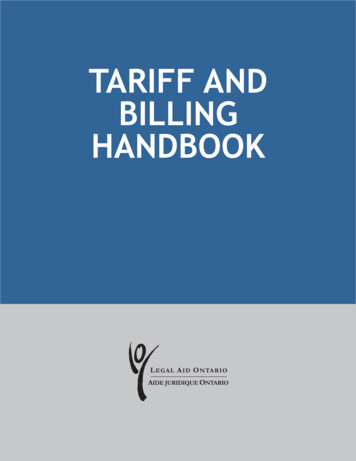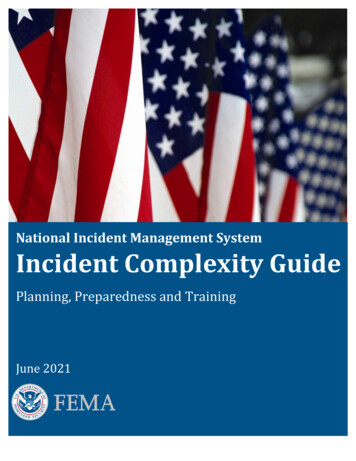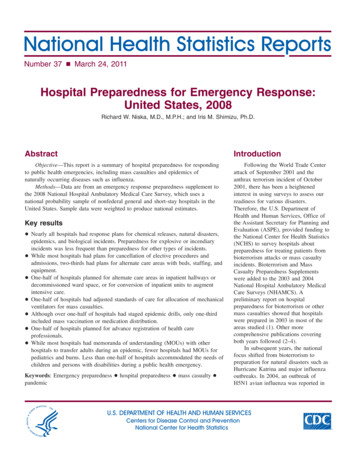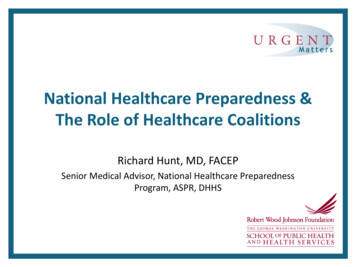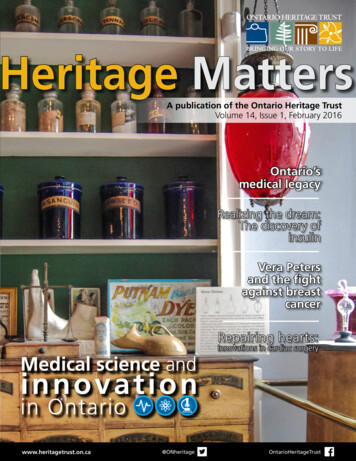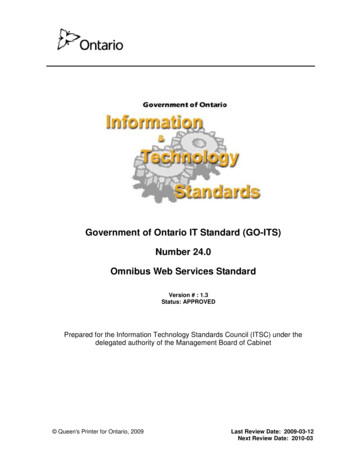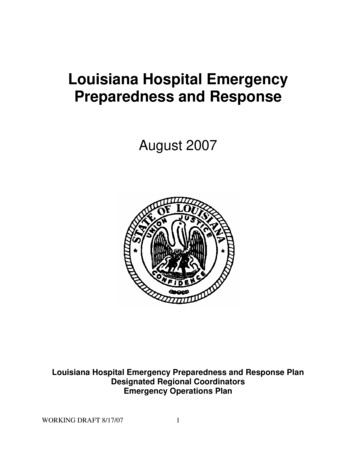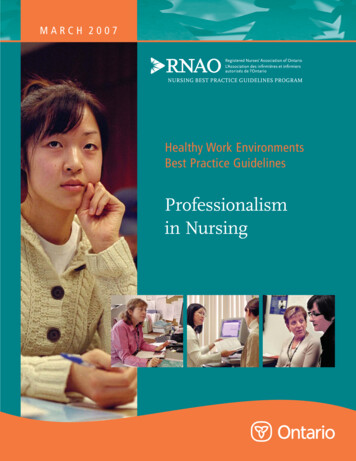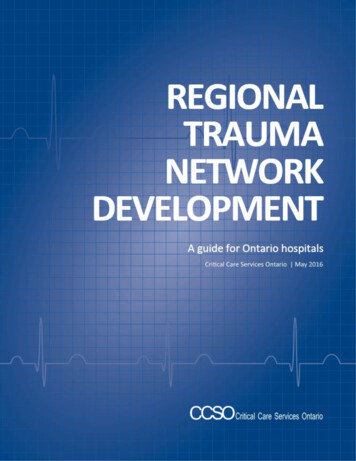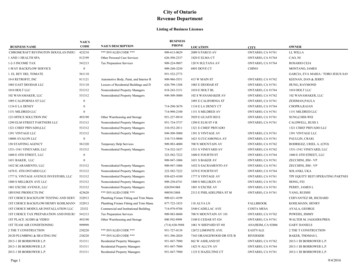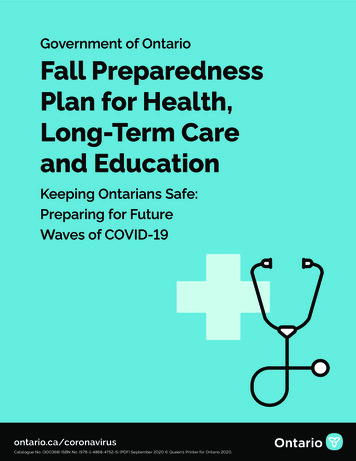
Transcription
Government of OntarioFall PreparednessPlan for Health,Long-Term Careand EducationKeeping Ontarians Safe:Preparing for FutureWaves of COVID-19ontario.ca/coronavirusCatalogue No. (300368) ISBN No. (978-1-4868-4752-5) (PDF) September 2020 Queen’s Printer for Ontario 2020.
Message from the Deputy Premier and Minister of HealthCOVID-19 has had a significant impact on everyone. During these unprecedented timesour government has made the health, safety and well-being of Ontarians our top priorityas we navigate through the evolving pandemic situation.Throughout the summer, our government has been working hard to ensure Ontario hasthe necessary resources in place to build the capacity we need to be ready for a secondwave of COVID-19 and the upcoming flu season.Ontario’s Keeping Ontarians Safe: Preparing for Future Waves of COVID-19 is acomprehensive plan to ensure our province is prepared. It sets out a series of steps toprevent, identify and respond to any outbreak scenario.Our partners across the health sector have demonstrated remarkable responsivenessto the COVID-19 outbreak. They’ve done so by simplifying the purchase of personalprotective equipment, supporting the staffing of long-term care homes and assessmentcenters, expanding virtual care options, and by breaking down long-standing barriersto achieve better connected care, both in support of patients and our brave frontlineheroes. The compassion, commitment and dedication from frontline health careworkers is truly admirable and the appreciation for their heroic efforts is shared amongstall Ontarians.Building on lessons learned from the first wave of COVID-19, Ontario’s fall preparednessplan was developed in collaboration with our health care partners to ensure our actionsand resources directly support their needs to keep Ontarians safe. This includes: Maintaining public health measures Implementing the largest flu immunization campaign in Ontario’s history Identifying, managing and preventing outbreaks quickly Reducing health service backlogs safely Preparing for any surges in COVID-19 cases Recruiting, retaining, training and supporting health care workers, while alsocontinuing to engage families and caregiversOur government will continue to work with all of our partners to protect the people ofOntario in our fight against COVID-19. Together, we will defeat this virus.Sincerely,Christine ElliottDeputy Premier and Minister of Health2
FallPreparednessPlan for Health,Long-Term Careand EducationKeepingOntarians Safe:Preparing forFuture Wavesof COVID-19The province’s top priority has been and will always beprotecting the health and well-being of all Ontarians.Ontario’s swift and decisive response, including being one ofthe first provinces in Canada to declare a state of emergency,helped to quickly flatten the epidemic curve. The vast majorityof Ontarians have been key to this progress by diligentlyfollowing public health measures to limit the spread of this virus.From the outset of the pandemic, the actions taken toenable the health system to respond quickly and effectivelyto COVID-19 have made a big difference in reducing thetransmission of COVID-19 and in the treatment of those whowere ill. Among the difficult, but necessary actions takento protect the health of Ontario residents were enactingemergency orders to reduce the size of public gatherings,closing schools and non-essential businesses temporarily, andrestricting the movement of health care workers to no more thanone congregate setting.Other critical actions in the fight against COVID-19 included: Significantly expanding testing and contact tracing capacity Establishing over 150 assessment centres province wide Ramping up domestic production of personal protectiveequipment Launching a massive public awareness campaign to informthe public about the measures they could take to protectthemselves and their loved ones Giving health care organizations the hiring and staffing flexibilitythey need to address surges in cases Implementing the COVID-19 Action Plan for Protecting Long-TermCare Homes to protect the province’s most vulnerable seniorsand those who care for them Delivering the COVID-19 Action Plan for Vulnerable Peopleto better protect those living in high-risk settings includingshelters and other congregate settings Providing free local child care to frontline and essential workersduring the initial period of the crisis3
Developing over 180 workplace safety and public healthguidance documents to help essential businesses operatesafely and help other businesses safely reopen Removing Ontario Health Insurance Plan (OHIP) limitations toensure that everyone has access to essential health services Launching the collection of race-based data to help Ontariounderstand how COVID-19 is affecting different communities Adapting funding models to support virtual delivery of morehealth care servicesThe province was able to gradually and safely reopenbusinesses, services and public spaces, and reunite residentsin care settings with their loved ones. However, as recentcase numbers in Ontario and across Canada have shown,the province’s fight with COVID-19 is far from over. Across thecountry and in Ontario, many regions are entering the earlystages of a second wave of COVID-19.To ensure preparedness for this and future surges and wavesof COVID-19, Ontario has developed a comprehensive plan toprepare our health care system for the challenges of the fall,including additional pressures for flu season, the need to clearthe backlog in surgeries and procedures, and continuing toensure all Ontarians have access to quality care when and wherethey need it. The first wave of COVID-19 has further exposed theinherited challenges the province is facing, including hallwayhealth care, ongoing staffing shortages, and insufficient case andcontact management preparedness.Overcoming these challenges and fortifying the front lines of ourhealth care system has been and continues to be a top priorityfor the province at this critical juncture. The plan was developedthroughout the summer in consultation with the Chief MedicalOfficer of Health and health experts, and the government isalready taking action to address the next wave of the virus.4
With an investment of 2.8 billion, this comprehensive andevidence-based plan focuses on preventing illness andprotecting communities by identifying six key areas of focus:1. Maintaining public health measures2. Implementing the largest flu immunization campaign inOntario’s history3. Identifying, managing and preventing outbreaks quickly4. Reducing health service backlogs safely5. Preparing for any surges in COVID-19 cases6. Recruiting, retaining, training and supporting health careworkers, while also continuing to engage families andcaregiversThe province released the COVID-19: Long-term carepreparedness which includes nearly 540 million in long-termcare investments to prepare long-term care homes for a secondwave of COVID-19. Ontario’s investments in long-term care will helphomes enhance infection prevention and containment, supportadequate staffing, manage operating costs related to COVID-19,and help people on the long-term care waitlist stay in their ownhomes longer through an innovative community paramedicine pilotprogram in development.Responding toNew ChallengesHeading into the fall, Ontario’s health system is facing a number ofchallenges that were not present at the time of the initial COVID-19outbreak: Flu season – The fall flu and cold season will increase demandsand pressures on the health care system while also leadingmore patients to seek testing Health service backlogs – The COVID-19 outbreak resultedin the tough but necessary decision to suspend surgeries,diagnostic imaging scans and other routine health services Overcrowding – There are growing hospital andemergency department volumes as health servicesresume; this is exacerbated by infection prevention andcontrol recommendations that reduce the use of sharedaccommodation to maintain distancing between patients5
Scenarios forthe Next Wave Reduced long-term care capacity – To ensure infectionprevention and control, there has been a reduction in sharedaccommodations in long-term care homes, which leads tomore people remaining in both the community and hospitalbeds while awaiting transfer to long-term care homes Health human resources shortages – COVID-19 exasperatedan already difficult situation. Our frontline health care providerswere already stretched prior to COVID-19 and the ability toattract and train new health care providers in various sectorshas been challenging. There is a need to expand the workforceso there are appropriate health care staffing levels in the rightplaces, such as in home and community care and in othercommunity settings especially long-term careThe Ministry of Health, working with epidemiological experts,scientific advisors and information from the Public Health Agencyof Canada, has developed scenarios for what COVID-19 levelscould look like this fall. Keeping Ontarians Safe enables Ontario tohave sufficient public health and health care capacity to respond toeach of these scenarios.These possible scenarios use scientific modelling to helpestimate how an infectious disease might take place. This doesnot predict what will happen but helps explain what may happenin certain situations.Slow BurnSmaller second wave; a few localizedoutbreaks that are quickly contained.Peaks and ValleysModerate second wave; some areas withlittle impact while others with localizedoutbreaks; infections in congregate settings.Fall PeakLarge second wave that targets healthcare systems in areas with high populationdensity; regional and local outbreaks thatare hard to contain; severe outbreaks incongregate settings.6
Help Stop the SpreadCOVID-19 is spread mainly from person to personthrough close physical contact. These everydayactions remain the best line of defence in helpingto reduce exposure to the virus and protectingyour health: Wash your hands often with soap and water oralcohol-based hand sanitizer Sneeze and cough into your sleeve Avoid touching your eyes, nose or mouth Avoid contact with people who are sick Stay home and away from others if you arefeeling sick, even if you have mild symptoms.If you have symptoms or think you have beenexposed to COVID-19, get tested Practice physical distancing – stay home asmuch as possible and limit outings, and stay atleast two metres away from anyone you do notlive with or is outside of your social circle Wear a face covering where required orwhen physical distancing of two metres is notpossibleAs we havealready seen, witha resurgence ofCOVID-19, either locallyor provincewide,targeted action maybe taken to adjust ortighten public healthmeasures. Data thatwill be consideredwhen making thesedecisions includecase counts andrates, the number andtype of outbreaks,hospitalizationsand admissions tointensive care units,the public healthsector’s capacity toconduct rapid case andcontact management,health system andtesting capacity, andconsultation with localmedical officers ofhealth.The publichealth measuresimplemented would be Download COVID Alert for free from the Appleas targeted as possibleand Google Play app stores. This new app letsand would dependusers know if they may have been exposed toon the situation,the virussuch as whether it isindividual outbreaksin institutions orworkplaces, multiple outbreaks in identifiable settings or widespread communitytransmission. The return to an earlier stage of provincial reopening, or evenregional approaches to tightening would be avoided in favour of organizationspecific or localized changes. For example, a specific workplace or organizationcould be closed for a period of time or have additional public health measures Ensure you are keeping to the public andprivate gathering limits (indoor and outdoor)7
or restrictions applied, or a certain type of higher-risk businessin a local area might be closed until trends in public healthindicators improve. However, if province wide measures mustbe taken to protect the health of Ontarians, the provincialgovernment, in consultation with health officials, will not hesitateto take action.For schools, the government has made 1.3 billion in resourcesavailable to school boards to support the safe return of students,teachers, and education staff to classrooms this fall.For early years and child care, the province is investing over 234.6 million to help safely reopen child care and EarlyONcentres through support from the federal Safe RestartAgreement. This is in addition to provincial and federal fundingthat has ensured the sustainability of the child care sector andis supporting the safe reopening of centres across Ontario.Together, these significant investments will help child careoperators, EarlyON Child and Family Centres, and First NationsChild and Family Programs increase cleaning and infectioncontrol, ensure staff have access to personal protectiveequipment, promote physical distancing, purchase additionalcleaning supplies, and support staffing needs.While public transit agencies like Metrolinx and OntarioNorthland Transportation Commission (Ontario Northland)would continue to operate their vital services through futurewaves of the pandemic, services may be temporarily reduced inline with a reduction in ridership. In the case that public healthmeasures are tightened or there are renewed requirementsfor organizations to limit workplace capacity, agencies wouldcontinue to ensure their vital transportation services areavailable to get essential workers where they need to go inthe safest manner possible. Metrolinx has implemented morethan 40 new safety measures, from mandatory face coveringsto enhanced cleaning and disinfecting to dividers betweenseats, to ensure the safest trip possible. Ontario Northland hasintroduced mandatory face coverings, increased cleaning,limited seating capacity and introduced passenger healthscreening prior to boarding.The province has further provided the province’s 110municipalities with transit systems, an additional 15 million8
for enhanced cleaning. This funding is in addition to the upto 4 billion made available through the federal Safe RestartFramework for Ontario’s municipalities, with 2 billion dedicatedto helping communities keep transit systems running safely.To protect vulnerable populations, the province is deliveringover 510 million through the Social Services Relief Fundto help municipal partners and charitable organizationscontinue to deliver critical frontline services at shelters andother congregate settings, as well as implement public healthmeasures to keep staff, residents and clients safe.While Ontario is prepared for the next wave of COVID-19, thebest way to combat this virus is to continue to follow strongpublic health advice that reduces the risk of transmission andhelps keep Ontarians safe.9
Objectivesto Focus andTrack Ontario’sPreparednessOntario’s plan to address impending health care challenges,including being prepared for a second wave of COVID, is guided bysix key objectives to prevent illness, protect Ontarians’ health andbuild capacity across the health system.1. Maintain publichealth measuresPrevention andProtection2. Immunize againstinfluenza3. Quickly identify, manage& prevent outbreaks4. Safely reduce healthservice backlogsIntegratedHealth SystemCapacity Plan5. Prepare for surges in casesand support delivery ofroutine health service needs6. Recruit, retain, train, andsupport health care workers,families and caregivers10
Maintain Public Continue to adhere to foundational public health measures as theHealth Measures province continues to enhance and expand efforts to test, traceand isolate new cases of COVID-19(Funding: 1.376 billion)Increased lab and testing capacityAccomplishments Established a provincial lab network with current capacity for40,000 daily tests Established comprehensive testing across the province Established over 150 assessment centres Tested more than 92% of long-term care staff and 97% of longterm care residents Long-term care homes to continue with staff testing at leasttwice a month Consistent improvements in the turnaround time for tests Invested 710 million to expand laboratory capacity and reducetesting backlogs Invested 360 million to support existing assessment centresand add more testing locations and capacityActions Underway Increasing testing capacity to conduct up to 50,000 daily tests,with additional capacity to surge up to 78,000 daily tests asneeded to support ongoing provincial reopening Expanding testing locations to provide access to Ontarians fortesting, including assessment centres and other communitysettings (mobile testing centres and pharmacies) Proactively adopt new testing technologies as they becomeavailable, like saliva tests or point-of-care testing techniques Ensure long-term care homes continue to implement theprovincial testing strategy for residents and staff11
Increase case management and contact tracing capacityAccomplishments Provided hundreds of additional contact tracers to supportpublic health units in contact tracing through an agreementwith the federal government Launched COVID Alert, the country’s made-in-Ontario exposurenotification appActions Underway Complete rollout of new case and contact management systemacross remaining public health units Continue to build additional human resource capacity for casemanagement and contact tracing Continue to encourage people to download the COVID AlertappStrong public health measures to prevent transmissionAccomplishments Public health advice has guided the province’s public healthmeasures, public awareness campaigns and regional reopeningbased on key public health indicators, testing, case and contactmanagement and epidemiological evidence (e.g., A Frameworkfor Reopening our Province) Launched a robust public awareness campaign to educate thepublic on how to keep themselves and their families safe Good public compliance with public health measures (e.g.,physical distancing, widespread use of face coverings)Actions Underway Health behaviour surveillance to see if people across Ontarioare following the public health measures and to helpunderstand how to better communicate the importance andbenefit of continuing to follow public health measures As needed, modify public health advice and actions based onepidemiological evidence and health behaviour surveillancedata12
Measuring Success – Maintaining Public Health Measures Faster turnaround time for testing: 80% of test results deliveredwithin 48 hoursImmunizeAgainst Flu(Funding: 70 million) Maintain test positivity rate under 3% Ensure sufficient case management and contact tracingcapacity to continue reaching 90% of cases within 24 hours Compliance with public health measures (based on healthbehaviour surveillance data)To help reduce the number of flu-related hospital admissions,Ontario will implement the largest and most comprehensive fluimmunization campaign in the province’s historyEnsure sufficient vaccine supplyAccomplishments Ordered 5.1 million doses of flu vaccine. This is 700,000 moredoses for this flu season than the estimated net usage lastseason Increased order for the high-dose flu vaccine for seniors by110,000, bringing the total quantity for this fall to over 1.3 milliondoses. This is over 218,000 more doses than last seasonActions Underway Purchase additional flu vaccine doses if required and availablethrough the national vaccine bulk procurement program Secure early delivery of flu vaccine doses by working withfederal government and other jurisdictions Prioritization of early vaccine shipments to the province forlong-term care homes and hospitals13
Effective vaccine distribution in appropriate places(e.g., pharmacies)Accomplishments For the first time in Ontario’s history, help improve access byallocating high-dose flu vaccines for seniors to pharmacies Close to 3,200 pharmacies participating in the flu vaccineprogram. This is 200 more than last season Engagement with key stakeholders and partners on planning,delivering and promoting the flu vaccineActions Underway Planning vaccine program delivery with public health unitsfocusing on high priority settings such as long-term carehomes, hospitals, retirement homes, congregate living andother vulnerable population settings Enhancing vaccine distribution and delivery for pharmacies toaccommodate increased volumes, and maximize delivery ofvaccines via primary care providersIncrease vaccination coverage, particularly for vulnerablepopulations and health care workersAccomplishments Allocate early shipments of flu vaccine to long-term carehomes, hospitals and retirement homesActions Underway Public education and targeted flu campaignMeasuring Success – Flu Immunization and Other Vaccines Higher number of doses distributed this year in comparison withthe 2019/2020 season Higher estimated vaccine uptake in comparison with the2019/2020 season14
Quickly Identify,Manage andPreventOutbreaks(Funding: 30 million)Stop the spread of COVID-19 through the quick and effectivemanagement of outbreaksEarly identification of outbreaks to prevent community spreadAccomplishments Developed a COVID-19 surveillance strategy to monitor thedisease and detect cases and outbreaks in a timely manner,including priority settings such as schools and long-term carehomes Launched a new case and contact management system,customized for Ontario, to improve data quality and timeliness,implemented across 31 of 34 health units, eliminating the use ofPublic Health Information System (iPHIS) for COVID-19 case andcontact management in all health units Established a Rapid Response Table comprised of public healthexperts, to help address outbreaks and support public healthunits in outbreak planning and response Appointed Dr. Dirk Huyer as Coordinator, Provincial GovernmentResponse, to coordinate the province’s efforts to prevent andminimize COVID-19 outbreaks in a number of sectors, includingthe education, child care, agriculture, long-term care and healthcare sectors Launched a new cross-government committee, chaired byDr. Huyer, to ensure alignment and coordination of plansand responses across ministries and sectors, supporting thegovernment’s health and public safety objectivesTo support all long-term care homes, staff and residents duringthese difficult times, the government has taken action to ensurethat long-term care homes can: Have the flexibility and funds to enforce social and physicaldistancing measures, such as increased bed availability toprovide isolation rooms Rapidly hire PSWs, nurses and other frontline staff they need,when they need them Restrict movement of staff between homes and other healthcare settings to limit the spread of the virus15
The government has also taken measures to: Partner with hospitals to support homes with medical expertisein infection prevention and control Enable hospitals to deploy health professionals to homesexperiencing critical staffing shortages Limit the admission of residents to ward rooms where anyoutbreak is more difficult to containActions Underway Undertaking regular surveillance activities to better targetprevention and response efforts Proactive testing, including testing of all symptomatic andasymptomatic staff, and symptomatic residents, in long-termcare homes Continuing to enhance reporting for key sectors whereoutbreaks might occur, including schools Reconvened the Long-Term Care Incident Management System(IMS) structure in September. The Long-Term Care IMS tablemonitors the data and organizes efforts to make rapid decisionsthat support long-term care homes in need. This includes thosestruggling to control outbreaks, complete infection preventionand control assessments, ensure appropriate staffing levels,access personal protective equipment (PPE), and complete thetesting of long-term care home residents and staff Meeting urgent staffing needs through our Health WorkforceMatching Portal, which matches a pool of workers with openpositions at long-term care homes and hospitals across theprovinceStrong partnerships and protocols to support provincial andlocal actions and responsesAccomplishments Regional integrated planning and refinement of outbreakprotocols Deployment of hospital and other partner infection preventionand control (IPAC) resources to support long-term care homes Created an outbreak ‘toolkit’ to support strong local responses16
Actions Underway Practice outbreak response protocols and response structuresthrough virtual simulation exercisesIsolation capacity to provide access to people without theability to self-isolateAccomplishments Continued implementation of the COVID-19 Action Plan forVulnerable People to better protect those living in high riskcongregate care settings including homes serving those withdevelopmental disabilities, shelters for survivors of genderbased violence and human trafficking, and children’s residentialsettings Pilot project by Toronto Public Health for people who cannotself-isolate in their family homesActions Underway More than 510 million provided through the Social ServicesRelief Fund to municipal Service Managers and IndigenousProgram Administrators to protect vulnerable populations,including supporting physical distancing and enhancedinfection control measures in congregate settings, and isolationfacilitiesMeasuring Success – Identifying, Managing and PreventingOutbreaks Rapid containment of outbreaks Fewer and less severe outbreaks in congregate and otherhigh-risk settings, including long-term care17
Safely ReduceHealth ServiceBacklogs(Funding: 283.7 million)Ensure the health system’s ongoing ability to reduce the backlogof surgeries while effectively managing COVID-19 and the fluseasonExpand capacity to reduce health service backlogsAccomplishments Provided guidance and parameters to the health sector for asafe restarting of non-emergency surgeries and procedures Used existing data sources to estimate backlog and developstrategy to address the surgical backlog The Provincial Primary Care Advisory Table worked with variousstakeholders on the development of guidance to primary careproviders for fall and winter 2020. This includes guidance forprimary care providers to proactively manage the backlog ofservices such as cancer screening and routine immunizations,and to prioritize appropriate in-person services that resultedfrom the delay in patients seeking careActions Underway Providing funding for additional surgeries (including cancer,cardiac, cataract, and orthopaedic procedures) to take placeduring extended hours, and additional diagnostic imaging hours Address backlog through innovative channels such as the useof alternate health facilities that can deliver additional publiclyfunded surgical and diagnostic imaging services Maintain current operations for hospital capacity and add bedsas needed to support increased surgical activity in hospitals Implement innovative solutions to address the surgicalbacklog, including: working to initiate a centralized waitlistand a program to optimize the use of the operating rooms toimprove the use of existing resources and increase the numberof surgical procedures in hospitals by hundreds on average peryear, and improve patient flow by leveraging available surgicalcapacity in each region Support the opening and accelerated ramp up of theCortellucci Vaughan Hospital and establish a regional approachto addressing surgical backlog in the Ontario Health CentralRegion18
Hospital projects that have recently been completed or reachedsubstantial completion include Groves Memorial Hospital,CHIGAMIK and Waypoint community health hub in Midland,Brockville General Hospital’s Phase II Redevelopment Projectand CAMH Phase 1C Client Care Building and Centre forDiscovery and Knowledge ExchangeShoring up PPE and critical health supplies to ensurecontinued delivery of careAccomplishments Amidst strained global supply, secured sufficient PPE to supportcurrent projected demands, as well as COVID-19 modellingscenarios Regional distribution model to ensure effective distribution ofPPE and other clinical supplies and equipment Established Ontario-based manufacturing supply sources ofcritical medical supplies such as hand sanitizer, gowns, faceshields and masks, including N95 respirators from 3M andventilators from Linamar and O-Two Medical TechnologiesActions Underway Allocate PPE to support restart and ramp-up of primary careand community health providers Support health service providers in maintaining an adequatesupply, and providing access to regional stockpiles to reducereliance on provincial emergency allocations In addition to ongoing support to health care providers, andtopping up of supplies in emergency situations, provide alllong-term care homes with a supply of PPE for up to twomonths, as a precaution against surges Continue to support and develop domestic supply of PPEsourcesMeasuring Success - Safely Reduce Health Service Backlogs Reduced backlogs with a focus on key priority areas (e.g.,cancer, cardiac, orthopaedic, cataract surgeries, as well ascritical diagnostic imaging procedures such as MRI and CT) Continued month-over-month increases in procedures andsurgeries performed throughout 2020-2119
Prepare forSurges inCOVID-19Cases(Funding: 457.5 million) Patient wait times for priority procedures and diagnostics startto decrease Increase percentage of health sector setting with adequate PPEsupply Continue to procure PPE and sustain a minimum of four weeksof emergency provincial pandemic stockpileEnsure that the health system is prepared to respond to anysurges of COVID-19 without interrupting routine health servicesIncrease community capacity to reduce pressure on hospitalsAccomplishments Provided virtua
Our frontline health care providers were already stretched prior to COVID-19 and the ability to attract and train new health care providers in various sectors has been challenging. There is a need to expand the workforce so there are appropriate health care staffing levels in the right places, such as in home and community care and in other
